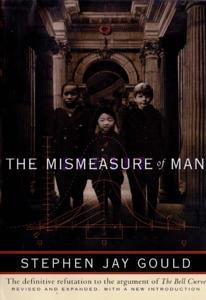
Want to learn the ideas in The Mismeasure Of Man better than ever? Read the world’s #1 book summary of The Mismeasure Of Man by Stephen Jay Gould here.
Read a brief 1-Page Summary or watch video summaries curated by our expert team. Note: this book guide is not affiliated with or endorsed by the publisher or author, and we always encourage you to purchase and read the full book.
Video Summaries of The Mismeasure Of Man
We’ve scoured the Internet for the very best videos on The Mismeasure Of Man, from high-quality videos summaries to interviews or commentary by Stephen Jay Gould.
1-Page Summary of The Mismeasure Of Man
Overall Summary
Stephen Jay Gould’s book, The Mismeasure of Man, is a survey and critique of 19th- and 20th-century theories that posited human intelligence was fixed. Under this argument, social and economic differences between human groups are the result of innate biological traits that can be measured as a single quantity. In his book, Gould analyzes scientific attempts to prove fixed numerical values for individual intelligence through measurement (IQ tests) or by using brain size as an indicator.
The book focuses on the science of craniometry, a field that was popular in the 19th century. During this time, scientists compiled numerical data to arrive at a rational and objective methodology for ranking racial intelligence. The author discusses early scientific findings in this field, as well as reexamines the work of leading scientists Samuel George Morton and Paul Broca. He argues that once unconscious bias is removed from their work, there’s no evidence for race-based intellectual difference. However, because quantifiable approaches were established theories about intelligence during this time period, published research was accepted without question by other researchers who used those same methods to support new theories about human evolution or criminal behavior based on race differences in intelligence.
The second part of the book focuses on intelligence testing during the 20th century. Gould examines Alfred Binet’s development of an IQ test, its intended use and how it was changed to be used as a number that represented one’s level of intelligence. He also looks at research by H.H. Goddard, L.M Terman and R M Yerkes that influenced widespread acceptance of this practice in America during the 1920s, which led to child labeling and negatively impacted national immigration policy quotas among other things
In the third section of the book, Gould discusses Charles Spearman, Cyril Burt and L.L. Thurstone, three intelligence researchers who popularized factor analysis in their research. In science, factor analysis is used to reduce complex relational systems into a singular dimension thereby simplifying systems and providing a reasonable means for interpreting disparate data points. Gould provides an in-depth critique of Spearman’s principal component and argues that his general intelligence factor (g) was too ambiguous and abstract to be useful as a tool for measuring human intelligence. He also criticizes Burt’s theory on racial differences in mental abilities by arguing that there are no real differences between races when it comes to IQ scores because all humans have the same intellectual potential; therefore any difference can only be attributed to environmental factors such as education or socioeconomics. The expanded edition of the book includes an update on Arthur Jensen’s use of g-factor theory in his own work which similarly concludes that race does not affect one’s ability to learn or perform well academically; rather it is solely dependent on environment or access to educational resources.
Gould concludes that the development of science relies on both new research and the refutation of outdated ideas. He believes that while scientists have a lot to learn about human behavior, they should be careful not to paint too limiting a portrait of humanity’s potential.
The revised and expanded version of The Mismeasure of Man includes an expanded critique of Richard J. Herrnstein and Charles Murray’s book The Bell Curve (1994) as well as a collection of three essays by Gould that examine historical writings on race and biodeterminism by Thomas Browne (17th century), J.F. Blumenbach (18th century), and Charles Darwin (19th century).





